
Several environmental groups, including one based in Fairfax County, have joined forces to challenge Gov. Glenn Youngkin’s decision to pull Virginia out of a cross-state initiative aimed at reducing carbon emissions.
The Southern Environmental Law Center announced on Monday (July 31) that it will appeal Virginia’s planned withdrawal from the Regional Greenhouse Gas Initiative (RGGI), a market of 12 states on the East Coast that regulates carbon emissions from power generators.
The appeal will be filed in Fairfax County Circuit Court on behalf of Appalachian Voices, the Association of Energy Conservation Professionals, Virginia Interfaith Power and Light and the Faith Alliance for Climate Solutions (FACS), a Fairfax County-focused coalition of religious communities pushing for action to address climate change.
The notice of appeal was served on the same day that the proposal to drop out of the RGGI was published in the Virginia Register, opening a period of public comments until the regulation takes effect on Aug. 30.
“The Regional Greenhouse Gas Initiative…has cut a huge amount of pollution from power plants, while protecting Virginians from the increasing impacts of climate change,” FACS Executive Director Andrea McGimsey said. “RGGI helps us leave a better world to our children and grandchildren, and we will continue to vigorously defend Virginia’s participation in this successful, bipartisan program.”
Established in 2005, the RGGI imposes a cap on carbon emissions from power plants in all participating states, requiring generators to buy “allowances” at quarterly auctions for every short ton of carbon they produce.
On Jan. 1, 2021, Virginia became the first southern state to join the initiative under then-governor Ralph Northam, who also signed legislation mandating an end to the use of coal-fired power plants after 2024 and requiring Dominion Energy to go carbon-free by 2045.
However, Youngkin issued an executive order on Jan. 15, 2022 calling for a reevaluation of Virginia’s participation and signaling his plans to withdraw. He argued that utilities have passed on the costs of purchasing allowances to customers, noting that residents served by Dominion Energy saw an average increase in their electricity bills of $2.39 per month.
Dominion suspended the surcharge after Youngkin announced his withdrawal plan, but last month, the State Corporation Commission approved its return. The fee of $4.44 for a “standard” customer will take effect on Sept. 1, even though the State Air Pollution Control Board voted 4-3 on June 7 to take Virginia out of the RGGI.
“RGGI remains a regressive tax which does not do anything to incentivize the reduction of emissions in Virginia,” Virginia Secretary of Natural and Historic Resources Travis Voyles said in a statement shared by Youngkin’s office. “…Virginians will see a lower energy bill in due time because we are withdrawing from RGGI through a regulatory process.”
Environmental advocates dispute the assertion that the RGGI hasn’t resulted in any benefits. In fact, Virginia saw an over 16% drop in power plant emissions after two years in the initiative based on Environmental Protection Agency data, according to FACS Vice Chair Scott Peterson.
The state also devotes half of its proceeds from the allowance auctions — totaling $250 million over the first two years — to energy efficiency programs for affordable housing and low-income households. Other funds have been used to support resiliency projects, most of them focused on reducing flooding impacts.
“There is a huge need for this funding not just in coastal areas, but also inland communities that are dealing with increasingly frequent intense storms,” Peterson said. “Almost $100 million has already been awarded to 98 different projects, but this work is long term and only getting started.”
The groups challenging the RGGI withdrawal argue that Youngkin’s administration lacks the authority to reverse a law adopted by the General Assembly. Their appeal must be filed in court within 30 days of the notice going to Air Pollution Control Board and Department of Environmental Quality officials.
“The administration cannot brush aside the laws it disagrees with,” Southern Environmental Law Center senior attorney Nate Benfornado said. “Moreover, Virginians deserve to see the continued benefits of this successful program. This program is vital to Virginia meeting climate goals, while reducing air pollution and improving public health.”
Voyles said Attorney General Jason Miyares’s office confirmed that the control board “has the legal authority to take action on the regulatory proposal using the full regulatory process — and the Board voted to do just that.”
Pending the legal action, Virginia will leave the RGGI when its three-year contract ends Dec. 31.
Photo via Ella Ivanescu/Unsplash
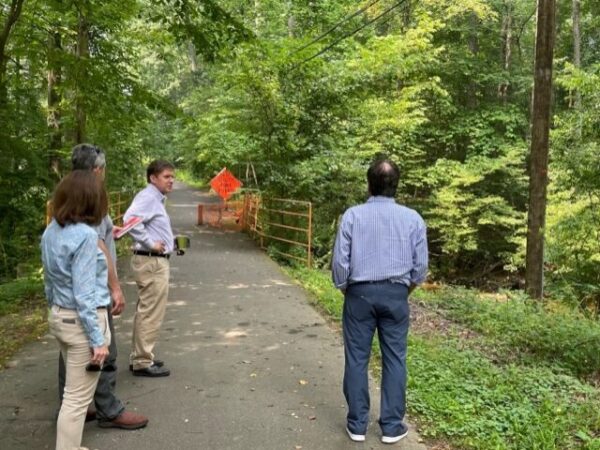
With development starting to pick up in the Spring Hill area, the need to protect some of the last remaining natural green space in Tysons has taken on a new level of urgency.
Acknowledging the potential threat, Hunter Mill District Supervisor Walter Alcorn — who represents Tysons west of Route 7 and north of Route 123 — will create a community task force to determine the best way to preserve Old Courthouse Spring Branch Stream Valley, also known as Tysons Forest.
“The Task Force will provide a forum for discussion and recommended action to maximize the ecological benefits of this green corridor while maintaining appropriate access by us humans,” Alcorn said in an announcement at yesterday’s Fairfax County Board of Supervisors meeting.
Encompassing over 40 acres of wooded land, Tysons Forest extends from the Ash Grove historic site down to the Tysons Towers apartments. It includes Raglan Road Park (8590 Raglan Road) as well as the stream valley park.
The area was dubbed “Tysons Last Forest” by residents who banded together in 2013 to halt plans for a road through Old Courthouse Spring Branch Stream Valley Park.
The county’s Tysons Comprehensive Plan emphasizes that the Old Courthouse Spring Branch and Scotts Run stream valleys “should not only be protected from development and infrastructure impacts, but be restored and enhanced.”
However, the plan also envisions “substantial redevelopment” for Tysons West to transform an area currently dominated by auto dealerships and offices into a mixed-use, transit-oriented district with “significant office, residential and retail components, as well as arts and entertainment uses.”
While that development mostly hasn’t emerged yet, the parkland is already close enough to human activities that a potential deer hunt last year was deemed too risky.
The plan proposes developing “multi-use trail and other passive recreational facilities” at Old Courthouse Spring Branch park, while considering athletic fields or other “local-serving recreational uses” at Raglan Road Park.
No changes to that plan will come from the new task force, which isn’t intended to address development in the area, Alcorn told FFXnow.
“Rather it is a task force of representative property owners along the stream valley to discuss management and ecological enhancement of this green corridor that forms the border of Tysons,” he said. “Some of the area has already completed stream restoration but there is as of yet no coordinated plan for the stream valley that lies between the Dulles Toll Road and Gosnell Road.”
According to Alcorn, the task force will be community-led and include representatives of property owners and other “community partners.” He said the other county supervisors and their staffs are also welcome to participate.
The group will convene this fall and is expected to wrap up its work in early 2024.
“It’s actually going to be a fun exercise to see how those ecological assets could be built upon and used for the broader community,” Alcorn said.
Alcorn’s full announcement is below: Read More
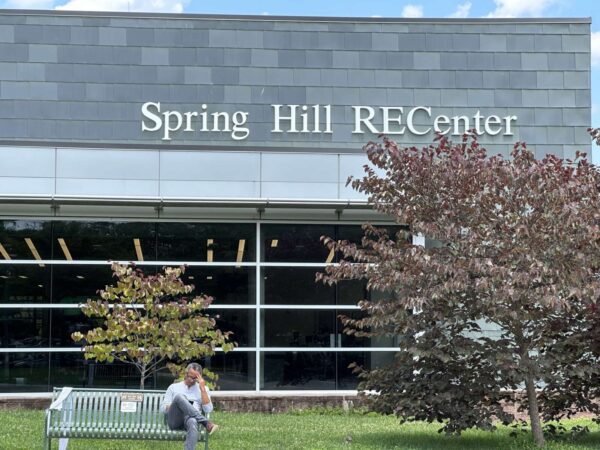
Fairfax County’s efforts to become more energy efficient will get a power boost this week, as work begins on improvements at McLean’s Spring Hill Rec Center.
Set to break ground at 2 p.m. tomorrow (Wednesday), the project will add the recreation center at 1239 Spring Hill Road to a growing list of county facilities supported by solar panels. Other planned changes include pool dehumidification unit replacements, LED lighting upgrades, improved building automation systems and a new geothermal HVAC system.
“The project represents a significant step forward toward meeting the county’s goals for carbon neutrality in its facilities, fleet vehicles and operations, including 50% of county electricity from renewable sources by 2040,” the Fairfax County Park Authority said.
Adopted in July 2021, the county’s Operational Energy Strategy set 2040 as the target date for achieving carbon neutrality in its energy use — the point when it will remove as many greenhouse gas emissions as it releases.
In addition to getting half its electricity from renewable sources by 2040, the county hopes to reach carbon neutrality by cutting overall energy usage in half, transitioning to fully electric or non-carbon-emitting vehicle fleets by 2035 and producing zero waste by 2030, among other goals.
After running into some early roadblocks, particularly when it came to solar panels, the push to make the county’s facilities more energy efficient has picked up steam in recent months.
There are 22 solar projects in progress, including the Spring Hill one as well as five others that are under construction and expected to be completed this year, the Fairfax County Office of Environmental and Energy Coordination reported to the Board of Supervisors at a July 18 committee meeting.
Later this afternoon, the board will hold a public hearing on whether to lease some upcoming facilities, including the new Franconia Governmental Center and planned Mason District Police Station addition, for solar photovoltaic (PV) array installations.
The county has also finished installing 96 electric vehicle charging stations at 11 facilities and has another five locations and 116 charging spaces on the way through 2024, though the Spring Hill Rec Center isn’t on that list.
The rec center will be the county’s fifth energy efficiency retrofit project, following completed upgrades at the Cub Run and South Run rec centers and the City of Fairfax Regional Library. Improvements to the Pender Building that houses the Department of Housing and Community Development are on track to finish this November.
According to the park authority, the Spring Hill Rec Center’s new solar PV array will produce 307 kilowatts of energy, providing 13% of the building’s annual electricity.
“That’s enough energy to power 33 homes, annually,” FCPA spokesperson Benjamin Boxer said.
Coordinated by energy service contractor CMTA, the upgrades are collectively expected to reduce the facility’s electric consumption by 19% and gas consumption by 29% each year, the FCPA says.
The park authority anticipates finishing work on the project by late summer 2024.
“There may be occasional, temporary disruptions to Rec Center operations due to construction activities, but the Park Authority will work to minimize any impacts to our patrons,” Boxer said.
Offering classes, camps and one of the FCPA’s three licensed preschools, the Spring Hill Rec Center hosts a 15,000-square-foot fitness center, an indoor gym, a swimming pool and spa, and various outdoor facilities, including a playground and baseball and soccer fields.
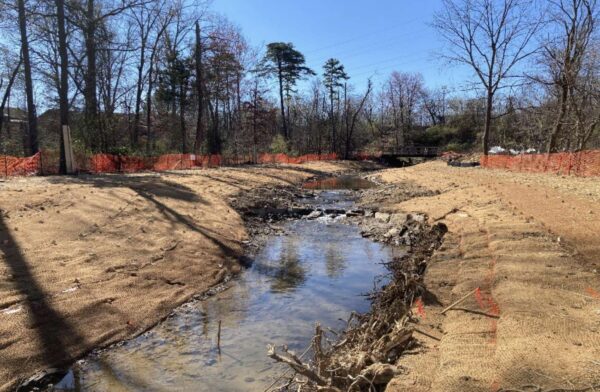
Planning is underway for stream restoration at Sugarland Run North.
At a Fairfax County Board of Supervisors meeting on July 11, the board unanimously approved an agreement between the county and the Town of Herndon to design and construct the project.
The $3.9 million project would restore roughly 2,350 linear feet of Sugarland Run, which is located in the Sugarland Run watershed. The project will begin roughly 1,200 linear feet north of the Washington & Old Dominion Trail crossing with Sugarland Run.
Sugarland Run South runs from Elden Street to the previously finished southern end of the project.
The town has asked the county to fund the design and construction of the project over four fiscal years.
“In addition to improving the environment and water quality, this partnership with the Town of Herndon is an example of implementation of effective and efficient government practices consistent with the County’s Strategic Plan,” county staff said a July 11 memo.
Staff noted that the partnership with Herndon will save the county time and administrative costs that would have piled up if the project was administered under the county’s own stormwater program.
The agreement is possible because the Town of Vienna, the Town of Herndon and Fairfax County have agreed to share some stormwater service district fees in order to meet stormwater management requirements for the Chesapeake Bay.
At a recent Herndon Town Council meeting, John Irish, the town’s deputy director of public works, noted that the primary goal of the project is to absorb and direct energy in a way that protects the geology of the stream. The project will improve the aquatic habitat of the area, address local flooding, and improve the safety and instability of eroded banks.
Channel erosion from the increased volume and velocity has led to significant nutrient and sediment pollution, along with the loss of habitats.
Construction on the northern project is expected to start in fiscal year 2026, which would start on July 1, 2025. Design work will begin in fiscal year 2024, according to the town’s website.
Photo via Town of Herndon newsletter
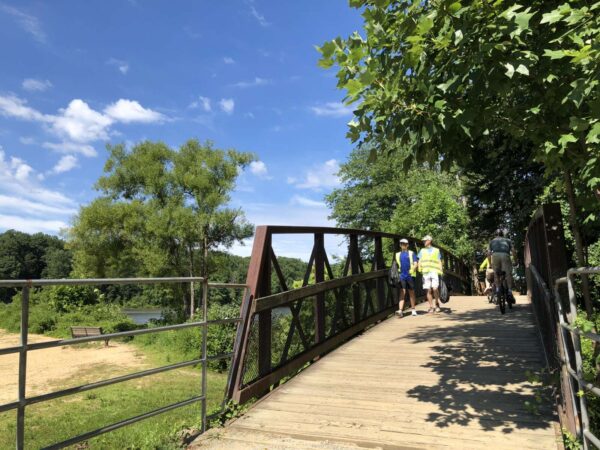
The Fairfax County Park Authority wants feedback on a draft plan to make county parks more equitable and accessible.
County staff is collecting input on its Parks, Recreation, Open Space, and Access (PROSA) Strategy through an online survey and two virtual workshops scheduled this month. The second round of community engagement comes as the FCPA prepares to finalize the strategy later this year.
FCPA Director Jai Cole said the strategy will guide the park authority toward improved accessibility, park equity, and a “stronger balance of park experiences countywide.”
“The cutting-edge research which we’ve undertaken, coupled with the valuable insights we’ve received by way of community input, will be invaluable tools in our work to ensure equitable access to our park system,” Cole said.
According to the county, top priorities of the draft PROSA report include:
- Ensuring all community members have access to FCPA parks within a 10-minute walk
- Enhancing access to “complete park experiences”
- Enriching habitat connectivity between environmental corridors
- Analyzing and prioritizing recreation needs and projects with an equity lens, as required by the county’s One Fairfax policy
According to the report, approximately 52% of residents have access to a county park within a 10-minute walk from their home.
Emphasizing its vision of ensuring residents can get to a park without driving, the report states that barriers can include the presence of large roadways with limited pedestrian crossings, a lack of sidewalks, remote park entryways and natural features, such as a stream or forested area.
“Opportunities to remove barriers and improve park access range from adding a trailhead or a new park entrance where feasible, to partnering with an agency to add a crosswalk, or acquiring parkland,” the PROSA report says.
Enhancing accessibility is also about improving the access visitors have to active, “passive,” social and natural or cultural recreation, according to the report, which proposes that the park authority develop parks with limited activities, acquire parkland, and collaborate with other public agencies to achieve its goal.
The objective of enriching habitat connectivity is centered on preserving and enhancing the county’s current and future natural environment.
“Improving habitat connectivity is a critical strategy for addressing habitat loss and fragmentation, a top threat to biodiversity,” the report reads.
The FCPA will identify sites where habitat health could improve, plant trees to bolster area with lower tree canopy, and consider opportunities to improve habitat connectivity when acquiring parkland.
The report commits the park authority to considering “racial and social equity and population density when prioritizing park and recreation needs and projects in order to diminish racial and social inequities within our community.”
The first round of community engagement on the PROSA strategy wrapped up last fall. The virtual workshop for the second round of community engagement is scheduled for July 18 and July 25. Comments through the online survey will be accepted through Aug. 6.
Registration for the online survey and workshops is available on the PROSA webpage.
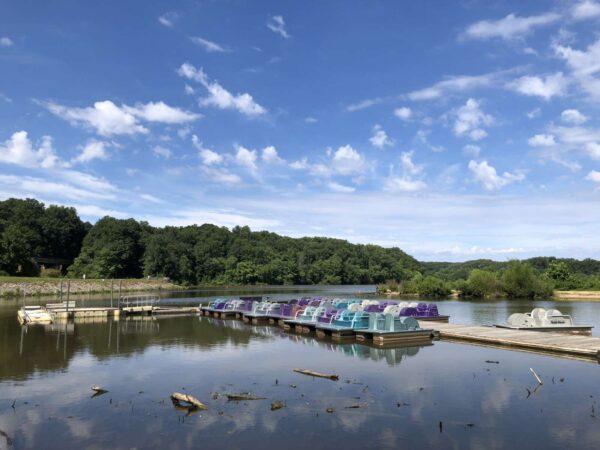
(Updated at 4:05 p.m.) Lake Accotink is off limits entering the Fourth of July holiday weekend after an upstream sewage spill potentially contaminated the water.
Fairfax County has shut down all activities on the North Springfield lake, including fishing and boating, while the water is tested for bacteria.
The closure took immediate effect and will remain in place “until further notice,” the Fairfax County Department of Public Works and Environmental Services (DPWES) said in a news release:
The Fairfax County Wastewater Management Program has identified a sewage spill upstream of Lake Accotink. Out of an abundance of caution, immediate closure of lake activities is recommended for activities involving contact with the lake, such as swimming and fishing, as the water may be contaminated. The closure is in effect until further notice.
Bacterial testing of the water is underway, and results are expected within 24 hours. Updates will be provided when the analysis is complete.
Precautionary signage is being placed near the area of the spill.
According to DPWES, the sewage spill came from “a blockage in a pipe carrying untreated sewage to a treatment plant.”
“As soon as the spill was detected, staff cleaned up any untreated sewage identified,” DPWES spokesperson Sharon North said, noting that the cleanup was completed by 12:30 p.m. “Follow-up testing is done in waterways to determine if downstream contamination occurred and to confirm when surface waters recover from spills.”
The closure comes as the community grapples with long-term threats to Lake Accotink Park, one of the county’s most popular recreational destinations. A task force charged with determining whether to maintain the lake through dredging, convert it into a wetland or develop a hybrid option met for the first time on Monday (June 26).
The park’s playground is also out of commission while the Fairfax County Park Authority installs new equipment, replacing a facility that was deemed unsafe.
Updates will be provided when the analysis is complete.
— Supervisor James Walkinshaw (@JRWalkinshaw) June 30, 2023
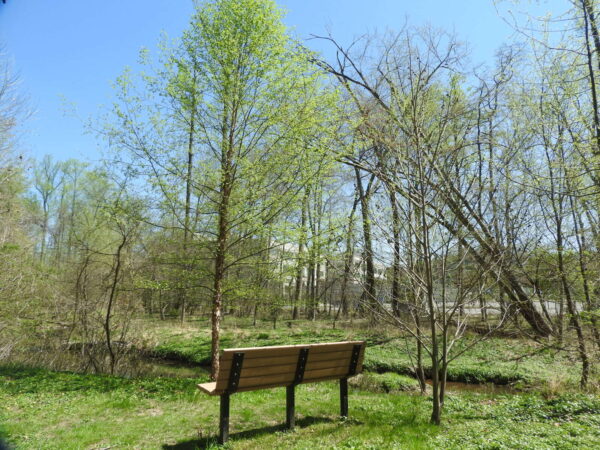
Vienna’s tree canopy may be shrinking, but the trees still standing are actually doing quite well, a recently released town-wide inventory found.
About 88% of the 7,224 trees on public land examined by PlanIT Geo are in “fair” or “good” condition, the consultant told the Vienna Town Council when presenting its findings on June 20.
“I’ve looked at a lot of data across a lot of projects, and I don’t think I’ve seen one as good of health as Vienna’s trees are in,” PlanIT Geo Director of Field Operations TJ Wood said, decreeing the town’s tree population to be in “very good health” overall.
That does still leave roughly 722 trees that were found to be in poor condition or dead, according to the inventory, which was initiated based on a recommendation by an urban tree canopy assessment that the town received last October.
Focused on trees on public property, including any within the street right-of-way and parks, the inventory identified tulip poplars as the species with the highest mortality rate at 12 dead trees. The species with the biggest showing in the “poor” category was red maple, which isn’t surprising when it constitutes 16.6% of the total inventory, Wood said.
He reported that, while Vienna has “a very diverse urban forest overall” with 162 unique species, the top 10 most common species make up almost 51% of the population, led by the 1,200 red maples recorded by PlanIT Geo.
“There’s a lot of room to diversify tree plantings and try new species out,” Wood said.
In another sign that Vienna could use some more trees, less than 30% of its trees have a diameter of 1 to 6 inches, suggesting the town is “lacking in new plantings.” Wood added that the town could get close to the ideal rate of 40% if it puts a tree in all 1,222 sites that the inventory identified as suitable for plantings.
Despite the overall healthiness of Vienna’s urban forest, the inventory says 3,968 trees, or 65% are in need of some maintenance. The majority are recommended for some kind of pruning to remove dead wood and hanging limbs or prevent them from growing into utility lines, signs and other infrastructure.
However, 290 trees were deemed to be at moderate risk, meaning they should be revisited at least once a year, and there are 25 high-risk trees.
“I would recommend anyone visit immediately and get another set of eyes on them, decide whether those need to be removed, or if there is a mitigating factor that can be done to reduce that risk to public safety,” Wood said, pointing to a red maple with a split trunk that could fall on a street or sidewalk as an example of a high-risk tree.
Vienna Park Maintenance Superintendent Jeremy Edwards noted that there are still some trees in parks, including Northside and Wildwood, that haven’t been examined and added to the inventory yet. The survey didn’t include trees on private property and along the Washington & Old Dominion Trail, which isn’t town-owned.
All of the data collected is now publicly available through a TreePlotter database that town staff will be able to update in real time.
Last year’s tree canopy assessment found that the town’s canopy has declined by 163 acres, or 13%, since 2011. In January, the town council designated improving the canopy as a top priority for 2023, and Vienna is currently considering an ordinance that would require developers to preserve trees, instead of just replacing ones they cut down.
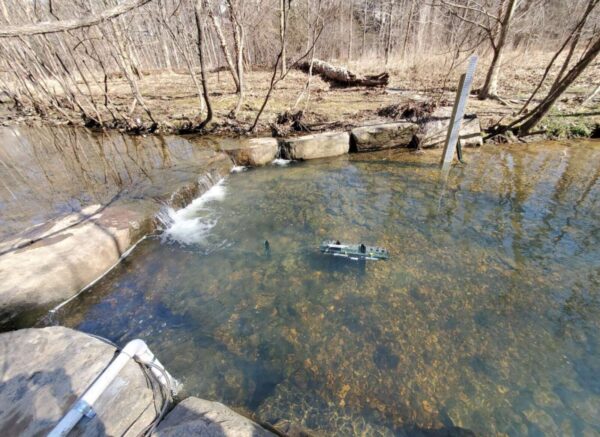
Several groups are working together to embark on a one-of-a-kind urban mussel restoration project for the Snakeden and Glade stream valleys in Reston.
The project is part of a partnership with Virginia Tech, the U.S Geological Survey and other institutions. The team will work to install mussel beds into restored streams and evaluate their ability to remove nutrient and sediment pollution.
“Freshwater mussels have the ability to filter stream water at a prodigious rate, improving water quality, and thereby potentially keeping local streams, rivers, and receiving estuaries cleaner,” the Resource Protection Group, a nonprofit funding the effort, said on the project page. “Within urbanized settings such as Reston, the possibility of utilizing mussels to improve both local water quality and that of larger receiving systems is quite intriguing.”
According to the organization, Virginia Commonwealth University and the U.S. Fish and Wildlife Service completed a study last year on whether freshwater mussels could survive in the streams before the current, larger-scale project to reintroduce the animals launched.
Other initiatives are also planned at both stream valleys.
A team of researchers from William and Mary and George Mason University will investigate the best ways to reduce the colonialization of stream restoration by grass and other invasive and non-native vegetation.
“We are excited to do our part to contribute to the science of stream management in our region by hosting these projects,” Reston Association said in an announcement on Friday (June 9).
Scientists are also working on studying water quality and vegetation management at both areas, which are part of the Northern Virginia Stream Restoration Bank Initiative.
RA COO Larry Butler noted that it’s not clear when the work related to invasive species will be completed, but it could take three to three-and-a-half years. The stream monitoring and mussel programs are expected to cost $2 million.
“The stream monitoring and mussel programs are five years with approximately four years remaining, with the work split between Snakeden Branch and the Glade watersheds,” Butler wrote in a statement to FFXnow.
Photo via Resource Protection Group
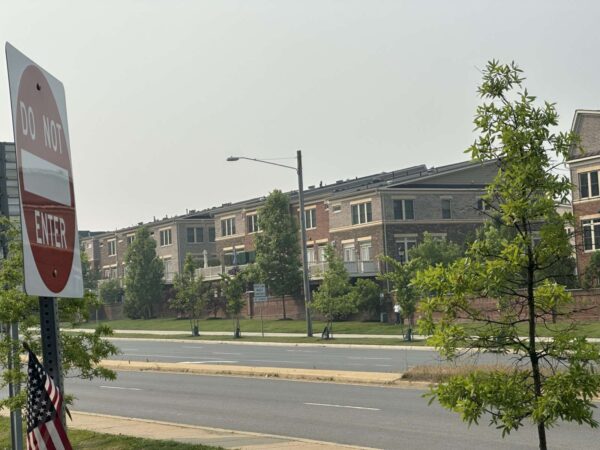
In an effort to reduce heat islands in vulnerable communities, the Fairfax County Department of Public Works and Environmental Services has applied for millions of dollars in grant funding to establish a street tree planting program.
The county will use its Vulnerability Index to identify communities in need of the program, according to county staff.
The Fairfax County Board of Supervisors approved the department’s request on Tuesday (June 6) to apply for a $11.5 million Inflation Reduction Act Urban and Community Forestry (UCF) grant from the U.S. Forest Service.
“The grant period is five years from the award date which is anticipated to be October 2023,” the board meeting package said.
Department of Public Works and Environmental Services spokesperson (DPWES) Sharon North told FFXnow the department is proposing to plant 1,000 trees over a five-year period. Although the county is looking at vulnerable communities, she said “no decision on the grant recipients will be made until October.”
The Forest Service announced the funding opportunity back in April. The UCF program received $1.5 billion under the Inflation Reduction Act to support urban tree planting and forest planning and management in at-risk communities.
“The Resilient Fairfax Plan notes that 91 percent of vulnerable households are in areas identified as having a significantly high urban heat island effect and that vulnerable populations are more likely to be impacted by extreme heat,” the package said.
Factors considered by the county’s vulnerability index include household income, education, English proficiency, health insurance and the percentage of the population that owns a home or vehicle.
If the county is awarded the funds, the program will also promote tree planting through partnerships with the Virginia Department of Transportation, the Fairfax County Park Authority, Fairfax County Public Schools, and nonprofit organizations.
The county also identifies specific activities that will receive the funding:
- identifying areas in the county that are heat vulnerable low tree canopy and/or areas where green infrastructure would provide additional community and resilience benefits
- planting and maintaining up to 5,000 native and/or climate-resilient street trees over five years in neighborhoods and within the right-of-way and on public property
- educating and engaging the public on the benefits of green spaces and trees
- expansion of a green workforce to maintain existing and new street trees.
The county launched a pilot program in 2021 that provides free trees to residents of areas with minimal tree canopy coverage. The program initially focused on the Richmond Highway corridor but was expected to shift to Bailey’s Crossroads this year.
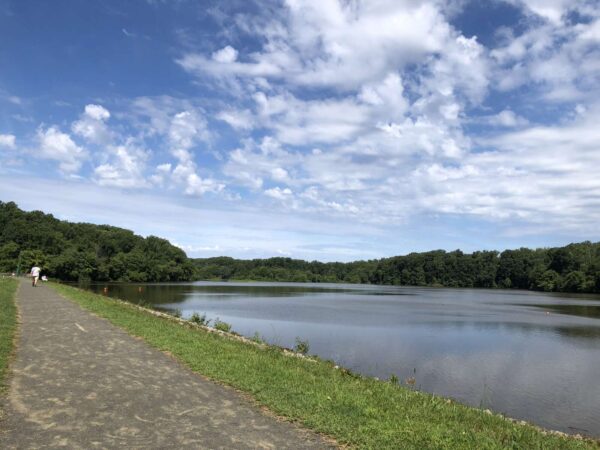
Questions continue to swirl around Lake Accotink Park’s long-term future, but that hasn’t stopped Fairfax County from pursuing some needed facility upgrades.
This Saturday (June 3), the Fairfax County Park Authority will celebrate the completion of its new Accotink Creek Crossing, a 320-foot-long concrete trail and 325-foot, elevated pedestrian bridge that closes 3.9-mile trail loop around the North Springfield park.
Coinciding with National Trails Day, the ribbon-cutting ceremony at 8:30 a.m. will be followed by a full day of outdoor activities, including nature and history hikes and a trail bicycle ride.
Under construction since last summer, the new crossing has improved the conditions and slope of the trail at the Lake Accotink dam outfall, according to the park authority.
“The previous stream crossing at the outfall of the Lake Accotink dam was subject to sudden and frequent flooding, often stranding trail users and tempting them to wade through swiftly moving water,” the authority said. “Additionally, excessive storm damage necessitated the total reconstruction of the trail twice within the last five years.”
The project was funded with just over $3 million from park bonds.
Playground replacement expected this year
Other impending improvements include an overhaul of the park’s playground, which has been out of commission since November after an inspector determined that the aging equipment was unsafe to use.
With $300,000 approved for a replacement, the park authority recently unveiled a design concept showcasing the features planned for the new playground, including a tower structure with a slide, four swings, a climbing net, a bouldering feature, a music feature, and a playhouse.

“In the interest of delivering a functional, safe and enjoyable playground experience as quickly as possible, this particular project was conducted as an in-kind replacement,” meaning it will fit within the footprint of the existing playground, FCPA spokesperson Benjamin Boxer said.
The new equipment is expected to be installed late this summer or by early fall, though the timeline could be revised “as ordering, delivery and installation details are finalized,” according to Boxer.
As the county develops a vision for the park’s future, which might not include a lake, the park authority says it intends to recommend adding a second, larger playground. Read More

